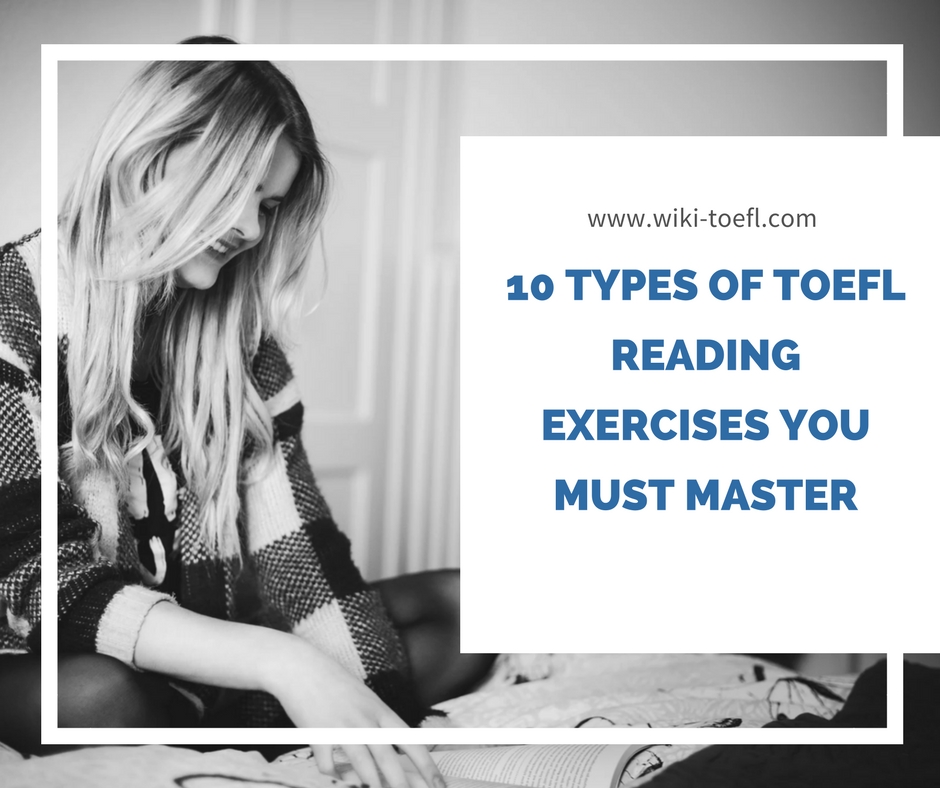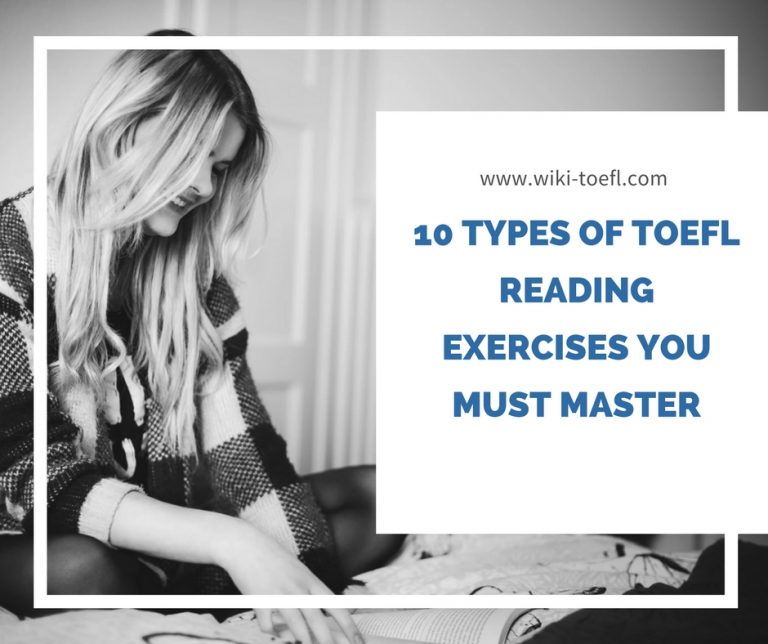Wondering why the TOEFL is so difficult, even for advanced English students?
Wondering why there are guides for every individual section of the TOEFL?
Every TOEFL section has very, very specific types of questions and tasks.
You need to know exactly what these questions are asking for in order to get the highest score possible on the test.
The Reading section is no exception. In fact, it has 10 different question types!
Each of these question types tests your ability to understand a written passage and express your understanding. You will need to effectively work with the information presented within the text.
Even if you understand everything you read, you might not be prepared for the types of questions and the answers they require!
To do well on the TOEFL, you need to work with exercises that match the test format as closely as possible. The Reading section tasks can be split into three general groups. Keep reading to learn all about them in this post!
All of the sample exercises below are based on an excerpt from pages 20-22 of “International Finance: Theory and Policy” by Steve Suranovic, accessible freely from The Saylor Foundation.
The 10 Types of TOEFL Reading Exercises You Must Master

Basic Information Questions
These tasks are based on the factual information present in the passage.
The correct answer will be stated in the text, often in just one or two sentences.
Are you able to locate the key information in a passage? If so, you should do well with the basic information tasks! They may be factual, negative factual or vocabulary-based.
1. Factual Information (3-6 questions per passage)
These questions target statements or facts explicitly present in the passage.
Passage:
Please go to page 20 of “International Finance,” linked above, and read the first paragraph. This paragraph begins with the phrase “Countries interact…”
Example:
According to the author in the paragraph, what does exchange rate measure?
1. The difference between import and export
2. The way to convert one currency into another currency
3. The speed of exchange of goods between countries
4. The rate of change in international trade
The correct answer is 2. Why? The paragraph states that the exchange rate measures the number of units of one currency that exchanges for one unit of another currency.
2. Negative Factual Information (0-2 questions per passage)
These questions ask you to identify what is not true about the passage you have just read.
Passage:
Please refer to page 22 of “International Finance,” specifically to paragraphs 2, 3 and 4.
Example:
According to the text, which country relies on a single foreign currency to maintain its exchange value?
1. USA
2. Russia
3. China
4. Germany
The correct answer is 3. China pegs its currency to the U.S. dollar, whereas Russia uses a currency basket.
USA and Germany are not mentioned in the paragraphs of the text that were indicated.
3. Vocabulary Information (3-5 questions per passage)
Everyone’s favorite, these tasks are all about how well you understand certain vocabulary in the context of the paragraph you are working with.
Example:
In paragraph 3, page 20, the word “backed” is closest in meaning to:
1. Bought
2. Sold
3. Returned
4. Supported
The correct answer is 4. “Backed” in this context means “supported by” or “influenced by.”
Inference Questions
The inference questions require that you work with the general meaning of the given paragraph in the passage. You must be able to inferinformation from the one explicitly stated.
Correct answers to these types of tasks will not be present in the text, but should be obvious if you comprehend the passage well.
4. Inference (1-3 questions per passage)
To answer an Inference question correctly, you should be able to understand an idea or an argument that is strongly implied, but not stated in the text.
Analyzing information in the paragraph(s) and thinking logically about it are key!
Example:
Which of the following can be inferred from the first paragraph on page 21?
1. The IMF regulates exchange rates throughout the world.
2. Independently floating currencies are uncommon in capitalist markets.
3. Central banks have full power to set the currency systems in their respective countries.
4. Exchange rate values remain largely stable over time.
The correct answer is 3. Every other choice contradicts the information in the paragraph.
5. Rhetorical Purpose (1-2 questions per passage)
While the factual information questions may ask you about the “what” or “how,” the Rhetorical Purpose section is all about the “why.”
If you understand the reasoning behind the author’s way of presenting information, you are good to go for the Rhetorical Purpose tasks.
Example:
Refer once again to page 22, paragraphs 2 and 4. Why does the author mention China and Russia there?
1. To demonstrate different types of fixed currency systems
2. To compare their economic performance
3. To illustrate the power their currencies play in the international market
4. To explain the benefits of free-flowing currency
The correct answer is 1, as both countries are simply listed as examples of different currency systems.
6. Reference (0-2 questions per passage)
Reference questions play the role similar to Vocabulary questions. They assess your ability to correctly identify the relationships between sentences, thus aiding the overall comprehension of the text. Usually, you will see a pronoun highlighted in the paragraph; your task will be to decide what it refers to.
Example:
The word “this” in Paragraph 3, page 20 (“…and this makes monetary policy contentious…”) refers to:
1. turbulent economic times
2. central banks’ abilities
3. gold-backed currencies
4. government’s decisions on policy
The correct answer is 2. The sentence discusses the implications of a central bank’s ability to achieve certain goals.
7. Sentence Simplification (0-1 question per passage)
Work hard at your ability to summarize and generalize the information you are given, because this is what Sentence Simplification measures. You will be presented with a sentence from the passage; the goal is to choose the answer sentence that summarizes it best.
Example:
Which of the following best expresses the essential information in the last sentence on page 20 (“Throughout history…”)?
1. The gold standard ensured that exchange rates remained fixed up until World War II.
2. The gold standard coupled with the fixed exchange rate agreement ensured the exchange rates remained stable in most countries.
3. The Bretton Woods system played a major role in guaranteeing that the gold standard remained in place.
4. After World War II, fixed exchange rates were adopted by most countries.
The correct answer is 2. The 1, 3 and 4 are either incorrect or only partially correct.
8. Insert Text (1 question per passage)
Frequently a challenging task, Insert Text tests your reading comprehension to the maximum limit! Understanding the text flow and mastering grammatical connections between sentences is essential for success here.
In this task, you will be given a new sentence and asked where in an existing paragraph it would fit best. Remember that there is only one correct answer.
Passage:
Paragraphs 2 and 3 on page 20.
Example:
Locate paragraphs 2 and 3 on page 20. They discuss currency conversion using a gold standard. On the test, four squares (■) would be inserted into the paragraphs to indicate where a new sentence could be added to the passage.
The correct answer will be the only paragraph out of four provided that makes sense grammatically and flows logically with the new sentence in it.
Reading to Learn Questions
The most difficult ones in the Reading section, Reading to Learn questions require that you work with the whole passage to find the right answers. Your ability to assess the information, recognize its purpose and distinguish major points from minor points in the passage are crucial. Often, you will also need a good grasp on cause-effect and compare-contrast rhetorical functions.
There are only two types of questions in this group. Both of them are worth two points each!
For the examples below, please refer to pages 20 to 22 of International Finance in their entirety. You can expect to see the following two types of Reading to Learn questions for them:
9. Prose Summary (1 per passage)
Somewhat similar to Sentence Simplification, Prose Summary will ask you to identify the major arguments of the whole passage. For this task, learn to recognize minor details and pay attention to the whole idea and argument of the passage instead.
You will be given six answer choices, out of which you need to pick three that best represent the major ideas of the text.
Passage:
Pages 20 to 22 of “International Finance.”
Example:
The passage describes the basics of exchange rates and how they are used throughout the world. What are the main points of the passage?
1. Countries rely on the exchange of currency to conduct trade and financial transactions across borders. Trade and investment are impossible without established currency exchange systems.
2. The European Union maintains a fixed exchange rate in between its member states, but a free-floating one in relation to every other country.
3. The gold standard was a traditional way of pegging currency to a commodity (gold) and basing the exchange rates on that.
4. The Bretton Woods system allowed countries to maintain fixed currency rates, and is still the norm today.
5. Several types of currency systems are in use today, including free floating, fixed and composite currency fixed, among others.
6. The IMF helps monitor currencies across the world, and every state’s central bank has to comply with its policies and Special Drawing Rights.
The correct answer choices are 1, 2 and 5. Number 3 is true, but is a minor point. The 4 and 6 are incorrect.
10. Fill In a Table (1 per passage)
This task measures your ability to structure and organize the information given to you in the passage. It will present you with an incomplete table that you need to fill in by dragging and dropping correct answer choices into their correct locations on the table.
You will be given more answer choices than there are spots on the table, so some will obviously be incorrect. Each answer can be used only once!
Passage:
Pages 20 to 22 of “International Finance.”
Example:
Countries with a fixed currency system:
1.
2.
Countries with a floating currency system:
1.
2.
3.
Answer choices:
- USA
- China
- Russia
- Japan
- France
- South Africa
- Estonia
The complete table should be filled in as follows:
Countries with a fixed currency system:
- Russia
- Estonia
Countries with a floating currency system:
- USA
- Japan
- South Africa
China’s currency is allowed to appreciate and hence is not fixed. France is not mentioned in the passage, but it is part of the European Union, whose currency system is unique (discussed at the end of the passage).
Doing TOEFL exercises should form the central part of your test preparation.
As you have just learned, the types of tasks found in the Reading section can be very complex.
You need to become very comfortable with all ten tasks to be able to focus on answering them correctly on the test.
Once you mastered all the Reading exercises available to you, you are all set for TOEFL success!

